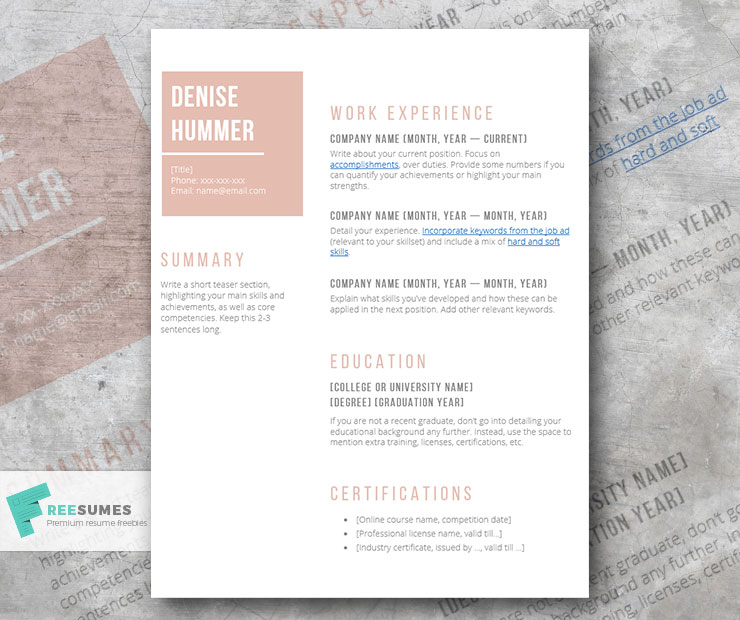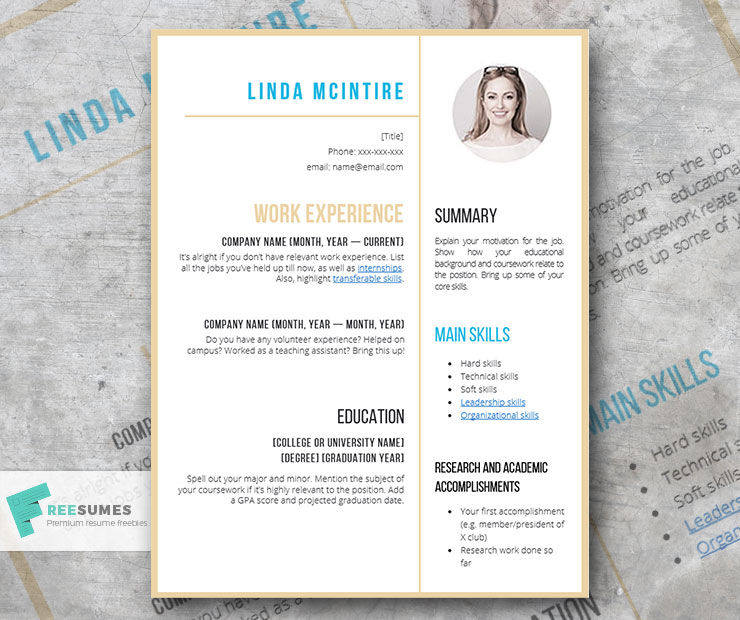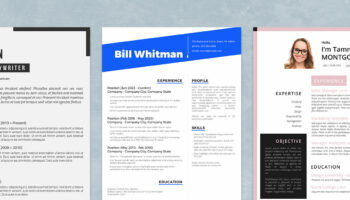Unless you are a professional resume writer, you can’t churn out a professional-sounding document in a couple of hours. To be the first among the many job applicants. But to get up to speed, you don’t need to become a certified pro. What you need is to master resume outline writing.
How Do You Write an Outline for a Resume?
Think of a resume outline as your scaffolding — a helping structure that helps you organize your skills and relay your work experience in a structured manner.
To create a professional resume outline, do some prep work first:
- Make a list of your core competencies — work areas where you excel most.
- Break those down into a list of your soft and hard skills. Prioritize them by marketability.
- Think about your latest accomplishments. What made you successful in every role?
- Make a list of extra professional training you’ve obtained on top/instead of your degree.
- Analyze the current job market. Are there any new in-demand skills among recruiters? Do you have them? Can you develop these fast?
- Dump all your thoughts into a plain word file. Then start outlining!
Start with a Resume Template
If you don’t want to start with a blank page, a professional resume template offers a fast track to writing productivity.
Resume templates provide a ready-to-use design with all main resume sections outline for you. All you have to do is fill in the blanks with your personal details. Once you are done, you’ll have a resume copy and reusable outline that you can customize for every job application fast!
If you use a professionally designed and eye-catching resume template, you will not have to start a new resume for each job application.
Resume Outline Examples
We know that you are after specific. So let’s get straight into action. Here are several sample resume outlines you can copy and use for writing (alongside our free resume templates!).
Simple Resume Outline
Here’s an outline for a resume with some writing prompts. We used one of our best resume templates for layout.

Download resume outline example for Word
Plain Text Version
[Name]
[Title]
Phone: xxx-xxx-xxx Email: name@email.com
Summary
Write a short teaser section, highlighting your main skills and achievements, as well as core competencies. Keep this 2-3 sentences long.
Work Experience
Company Name
Month, year — current
Write about your current position. Focus on accomplishments, over duties. Provide some numbers if you can quantify your achievements or highlight your main strengths.
Company Name
Month, year — current
Detail your experience. Incorporate keywords from the job ad (relevant to your skillset) and include a mix of hard and soft skills.
Company Name
Month, year — current
Explain what skills you’ve developed and how these can be applied in the next position. Add other relevant keywords.
Education
[College or University Name]
[Degree] [Graduation Year]
If you are not a recent graduate, don’t go into detailing your educational background any further. Instead, use the space to mention extra training, licenses, certifications, etc.
Certifications:
- [Online course name, competition date]
- [Professional license name, valid till..]
- [Industry certificate, issued by …, valid till …]
College Student Resume Outline

Download college student outline example for Word
Plain Text Version
[Name]
[Title]
Phone: xxx-xxx-xxx Email: name@email.com
Summary
Explain your motivation for the job. Show how your educational background and coursework relate to the position. Bring up some of your core skills.
Main Skills:
- Hard skills
- Technical skills
- Soft skills
- Leadership skills
- Organizational skills
Work Experience
Company Name
Month, year — current
It’s alright if you don’t have relevant work experience. List all the jobs you’ve held up till now, as well as internships. Also, highlight transferable skills.
Company Name
Month, year — current
Do you have any volunteer experience? Helped on campus? Worked as a teaching assistant? Bring this up!
Education
[College or University Name]
[Degree] [Graduation Year]
Spell out your major and minor. Mention the subject of your coursework if it’s highly relevant to the position. Add a GPA score and projected graduation date.
Research and Academic Accomplishments
- Your first accomplishment (e.g. member/president of X club)
- Research work done so far
Need more inspiration for outlining? Check our jumbo-sized collection of resume examples. Each sample comes with detailed instructions for resume formatting, structuring, and customization!
How to Outline Your Resume Like a Pro
Resumes are structured business documents. Consequently, you will have generic parts that can be left pretty much intact once they are written out.
So as a first step, sort out:
- Resume header area featuring your name, title, contact information, and website/LinkedIn links (optional).
- Resume body: put down a work experience and education section. Leave some space at the end of the page for a featured Skills or Extra Qualifications area. You can scrap both if needed easily.
Stick with a professional resume font, used consistently for headers, subheads, and main texts. Don’t mix different fonts unless you have a design streak in you.
Then move on to the next tips for fleshing out your resume outline.
Choose Which Section Comes First
You have some flexibility when it comes to the first section of your resume. For instance, you can go for a:
- Formal resume objective
- Resume summary of qualifications
- Personal branding statement
- Informal “About Me” section
There’s no right or wrong option here. The choice really boils down to your industry, experience levels, and the type of company you are applying for. As a creative professional after a hip agency job, you may do better with a resume summary or personal branding statement. But if you are after an executive or corporate job, an objective may be more preferable.
Next, you’ll have to decide on your resume format.
You have three options:
- Chronological resume format — first comes the Work Experience section in reverse chronological order, followed by Education.
- Functional resume — rather than listing work experience entries, you put down a longer summary of qualification and skills section first. Then detail education and work experience.
- Combination resume format — a mesh of the earlier two. Opens with a longer skills section, followed by a chronological work experience section.
The earlier resume outline examples were in chronological format. This is the standard type most employers favor.
Structure Your Subsections and Make Headings
Your section heading acts as a shortcut so that the employer reading your resume can jump to the sections that they are interested in without having to read your whole resume.
Put down the standard resume section first:
- Header
- Summary
- Skills
- Work Experience
- Education and training
Then organize your information around them.
A resume outline is a flexible document. Save several versions. Tweak headings and add, remove, or swap sections if that makes sense.
Make a Generic Resume First, Then Tailor
Writing an all-purpose resume first is a great time saver in itself because it stops you from staring at a blank page. Plus it makes customization all-so-easy!
Start by filling out each section of the outline with your information based on facts. This will be easy to do with your education section because you will already know your schools and colleges, the dates attended and qualifications gained.
Then tackle the Work Experience section. Don’t go too long here. If you have a long career history, focus on the most recent employment you have had. Prioritize accomplishments over duties.
Also, keep each section under 4 sentences long to fit everything into a one-page resume. Use bullet points, instead of full sentences to save space.
Once you have filled out your resume template you can then use this as your base document. As each new job opportunity comes along, you can then go back to your resume template to tailor it to suit the position that you are applying for.
Focus On Keywords
When you see a job that you want to apply for, take the job advert and the job description and study it carefully.
Note down any industry keywords they use within the job description and try to pick up the tone of voice they use in their language. Incorporate those keywords into your resume to whizz past the ATS systems, plus appear more relevant to the hiring manager.
By tailoring your resume content to match the information on the job advert and job description, you will be showing that you actually care about your presentation and are truly interested in the job. This will help to secure you more interviews and increase the chances of you landing a good position that has great career prospects.
Keep Separate Copies Of Your Resume
Go to your basic resume outline and save a copy that you will use with this job application. By doing this you will always have an original copy of your resume on file that isn’t tailored with the keywords and ‘company speak’ for one specific employer.
This will save you a lot of time and effort in the future because you will always be able to go back to your original basic resume content and make a fresh copy to edit. This is quicker than having to reverse all of your last modifications from your previous edit before tailoring it to the next employer.
Final: Time-Saving Resume Writing Tips
Here are some time-saving tips to help cut down on your procrastinating and get your resume written in double-quick time.
- Challenge yourself to a time limit: When you want to tailor your resume for a new job application, challenge yourself to get it done in 30 minutes. You can set a timer and decide on a reward for achieving your goal. This could be treating yourself to ice cream or an extra episode of your favorite show on Netflix.
- Turn off your distractions: Log out of Facebook, Twitter, emails, the internet, and your phone. Once you can focus on your resume re-writing tasks your mind will get into the zone. There will be nothing to break your concentration or interrupt your flow.
- Break up long sentences and paragraphs: Use bullet points to highlight key skills and information. This saves you a lot of time because you will not need to write a lengthy descriptive text. Keeping things short and to the point is also useful for delivering your information as quickly as possible to an employer.
Using these tips will not only help you save time and effort with rewriting and tailoring your resume but will also make the process more enjoyable by cutting out distractions!






